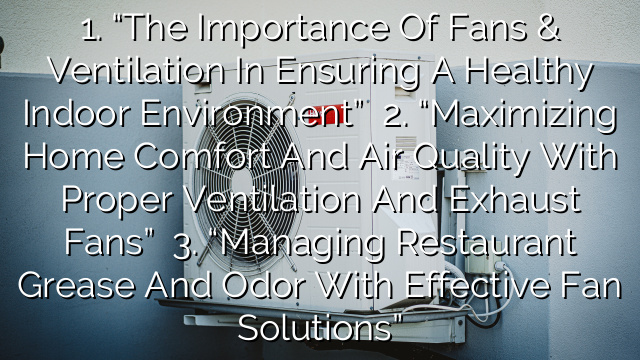Introduction
Ventilation and exhaust fans play a crucial role in maintaining a healthy and comfortable living environment in our homes. They help remove stale air, control humidity levels, and eliminate odors, allergens, and pollutants. Whether you’re looking to improve indoor air quality or prevent moisture-related issues, this guide will provide you with the essential information you need to know about home ventilation and exhaust fans.
The Importance of Home Ventilation
Good ventilation is essential for maintaining indoor air quality. Inadequate ventilation can lead to a buildup of harmful pollutants, such as carbon dioxide, volatile organic compounds (VOCs), and particulate matter. Poor ventilation can also contribute to the growth of mold and mildew, which can lead to respiratory problems and other health issues.
Ventilation helps to remove odors, smoke, and excess moisture from our homes. It also helps regulate temperature and humidity levels, creating a more comfortable living environment. Additionally, proper ventilation can help prevent the formation of condensation, which can lead to mold growth and structural damage.
Types of Home Ventilation Systems
There are several types of home ventilation systems available, each with its own advantages and applications. Here are some of the most common types:
- Natural Ventilation: This is the simplest form of ventilation and relies on natural airflow through windows, doors, and vents. While effective, natural ventilation may not be sufficient for homes in areas with high pollution levels or extreme weather conditions.
- Mechanical Ventilation: Mechanical ventilation uses fans, blowers, and other mechanical devices to remove stale air and introduce fresh air from outside. There are two main types of mechanical ventilation systems: exhaust ventilation and supply ventilation.
- Exhaust Ventilation: This type of system focuses on removing stale air from specific areas, such as kitchens and bathrooms. It uses exhaust fans to pull out polluted air and can be integrated with ductwork for optimal performance.
- Supply Ventilation: Supply ventilation systems push fresh outdoor air into the home, typically through fans and ducts. These systems help maintain a constant supply of fresh air and can be beneficial in areas with high pollution levels.
- Heat Recovery Ventilation (HRV) and Energy Recovery Ventilation (ERV): HRV and ERV systems are advanced mechanical ventilation systems that not only remove stale air but also recover heat or energy from the outgoing air. These systems help improve energy efficiency and can be particularly useful in cold climates where heat loss is a concern.
Choosing the Right Exhaust Fan
When selecting an exhaust fan for your home, there are several factors to consider:
- Airflow Capacity: Ensure that the fan has sufficient airflow capacity to effectively remove the amount of air in the space. Consider factors like room size, ceiling height, and the number of air changes per hour required.
- Noise Level: Look for fans with low noise levels, especially if you plan to install them in bedrooms or living areas. Manufacturers often provide noise ratings (measured in sones) for their fans, allowing you to choose a quieter option.
- Energy Efficiency: Opt for energy-efficient exhaust fans to reduce energy consumption and save on utility bills. Look for fans with an Energy Star rating, as they meet strict energy efficiency guidelines.
- Installation Requirements: Consider the installation requirements and whether you prefer a wall-mounted, ceiling-mounted, or inline fan. Ensure that the fan can be easily installed in the desired location.
- Additional Features: Some exhaust fans come with additional features like built-in lights, humidity sensors, and timers. These features can provide added convenience and functionality.
Maintenance and Cleaning
Proper maintenance and regular cleaning are essential to ensure the optimal performance and longevity of your ventilation and exhaust fans. Here are some tips to keep in mind:
- Clean or Replace Filters: If your ventilation system has filters, clean or replace them on a regular basis to prevent clogging and maintain airflow.
- Clean Fan Blades and Housings: Dust and dirt can accumulate on fan blades and housings, affecting performance. Clean them regularly with a damp cloth or vacuum cleaner.
- Check and Lubricate Moving Parts: Check moving parts, such as bearings and motors, for wear and tear. Lubricate them as recommended by the manufacturer.
- Inspect Ductwork: Regularly inspect the ductwork for any leaks, blockages, or damage. Repair or replace any damaged sections to ensure proper airflow.
Frequently Asked Questions (FAQs)
- How often should I turn on my ventilation system?
It is recommended to run your ventilation system continuously or for extended periods, especially in areas with high humidity or pollution levels. This helps maintain a constant supply of fresh air and prevents the buildup of pollutants.
- Can I install an exhaust fan myself?
Yes, exhaust fans can generally be installed as a DIY project. However, it’s important to follow the manufacturer’s installation instructions and ensure proper electrical connections and ventilation ductwork.
- How do I determine the appropriate airflow capacity for an exhaust fan?
The recommended airflow capacity for an exhaust fan depends on the size and use of the space. As a general guideline, a fan should be able to replace the air in a room 8-10 times per hour. However, consulting a ventilation professional can help determine the specific airflow requirements for your home.
- Can I use an exhaust fan instead of opening windows for ventilation?
While exhaust fans can help remove stale air and maintain air quality, they are not a substitute for natural ventilation. Opening windows and allowing fresh air to enter is still essential for ensuring proper airflow and circulation.
- Are there any health risks associated with poor home ventilation?
Poor home ventilation can lead to a variety of health issues, including respiratory problems, allergies, asthma exacerbation, and the spread of airborne diseases. Ventilation helps remove pollutants and maintain a healthy indoor environment.
By understanding the importance of home ventilation and exhaust fans, selecting the right system for your needs, and maintaining it regularly, you can create a healthier and more comfortable living space for you and your family.














